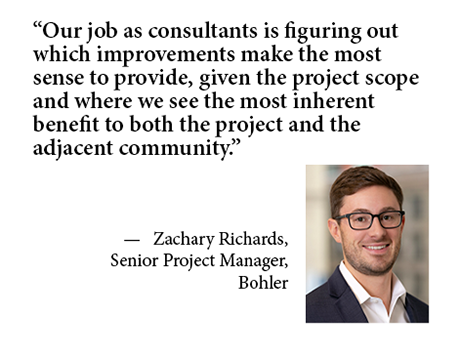Commercial property conversions can offer significant advantages over conventional ground-up real estate developments. Conversions can provide a head start on construction with established entitlements, existing structures, in-place utilities and entry to choice locations in otherwise built-out submarkets.
Consider the Universal Buildings, Post Brothers’ conversion of two 1960s-era office buildings into more than 600 residential units and ground-floor retail just north of the District of Columbia’s Dupont Circle. The 15-story complex will feature a two-level, glass-walled fitness and recovery center with more than 10,000 square feet of training zones, equipment and classrooms. The developer is housing the fitness center and other amenities in a new atrium that replaces the upper levels of structured parking originally built within one of the former office buildings.

“The location is incredible — there is probably no greater location in any major city in the country for conversion,” says Josh Guelbart, Post Brothers’ Co-Chief Operating Officer. “Having the entire block means we have light, air and hilltop views of Kalorama, Adams Morgan and Dupont Circle, three of the finest residential neighborhoods in the District. There isn’t room for new buildings of scale in those neighborhoods, and that really made this existing, large building attractive to us.”
For Post Brothers, large scale is essential in a conversion to residential. The developer prefers building from the ground up or converting properties into 500 or more residential units, a threshold of rent-producing space necessary to support the lavish fitness centers, pool clubs, coworking space and similar amenities that have become a Post Brother’s hallmark.
A challenge for developers is achieving the necessary number of rental units while also providing resident amenities and any improvements required by the municipality or state. “Our objective is always to maximize world-class residential space for our residents,” Guelbart says.
Upgrades, Costs, Feasibility in Adaptive Reuse
The dual need to minimize costs and generate rent puts pressure on the architect and design team to make the most of existing infrastructure and find places for improvements, like a new electrical substation to support hundreds of appliances during peak usage. A project team experienced in conversions can help evaluate the feasibility of repurposing existing structures and identify sections that will likely need to be upgraded or demolished.
Post Brothers retained Bohler to pilot the project — Post Brothers’ first venture in the District — through about two years of planning, zoning and permitting. “Washington D.C. offers a clean and clear process that benefits experienced developers like us. There are very few challenges in moving a project forward, which we credit to existing local policy,” Guelbart says. “Bohler was a great help in getting us through.”
Conversions bring their own brand of challenges, so developers should ensure a property is suitable for the intended use early on. Existing zoning for the Universal Buildings allowed residential use by right, which helped streamline negotiations with local government.
By-Right Case Study: Broad and Washington, Philadelphia
The ability to develop residential by right was also a key selling point at Broad and Washington, a Post Brothers redevelopment taking shape at the intersection of Philadelphia’s Avenue of the Arts, East Passyunk and Italian Market neighborhoods. Now under construction on a former parking lot, Phase I is expected to deliver some 600 apartments and 50,000 square feet of ground-floor commercial space in 2024.
Here, redevelopment allowed the developer to enter a targeted market with high barriers to entry.
“That neighborhood, much like the one in D.C., is surrounded by very desirable townhome blocks,” Guelbart says. “People want to live there, but there are no apartment buildings offering the scale and great features of apartment living that we are bringing to this desirable, walkable, beautiful neighborhood.”
Bohler helped Post Brothers and its partner, Tower Investments, obtain site plan approval and a building permit for Broad and Washington based on conceptual plans to meet a looming deadline for a vital tax abatement for the project. The team then fine-tuned project plans through approval amendments, navigating design challenges that included utility due diligence and working around a subway tunnel to place underground parking, a deep stormwater management basin and rerouted sewer connections.
Coordination is Key
Few properties offer an easy path for conversion to a different use, and unexpected problems or expenses can jeopardize success. That’s why land development consultants like Bohler work to identify potential permitting and site civil engineering challenges early on and help client developers incorporate solutions into their plans and budgets.
Zachary Richards, a senior project manager at Bohler, says communities often look for developers to incorporate improvements that go beyond the simplest interpretation of zoning requirements and building codes. Experience helps design teams anticipate these requests and help clients prepare their responses, including strategies to cost-effectively incorporate some of those features.
“There’s some negotiation that goes into working with the municipality and landing on a scope of work that’s feasible for all the parties involved. Early discussions are a good opportunity for developers to uncover potential requested improvements or mitigation, whether it be stormwater infrastructure, pedestrian access, landscaping or off-site improvements relative to traffic,” Richards says.
Meeting deadlines and providing the appropriate application materials the first time can reduce the turnaround time on approvals, Richards says, but working with municipal staff and officials is an ongoing process. Even after shell construction is complete, Bohler is often called in to assist with changes required by incoming tenants.
“The bottom line is, conversions take some thoughtful planning and can often still require several years to come together,” Richards says. “Some developers that started the process years ago now have the capacity to serve tenants, and we’re working with them through tenant-specific improvements.”
“Our job as consultants is figuring out which public improvements make the most sense to provide, given the project scope and where we see the most inherent benefit to both the project and the adjacent community. We try to identify what the municipality will ask for and get those features and costs into the developer’s planning and design process early, versus waiting for those requests to be surprises later on in the project.”
— By Matt Hudgins. Bohler is a content partner of REBusinessOnline. For more articles from and news about Bohler, click here.


